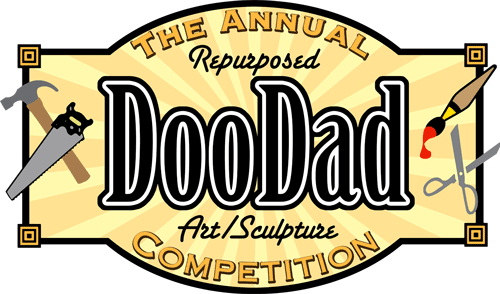Welcome to the 2025 Repurposed DooDad Sculpture Competition Gallery!
We are happy to present all scultpures and Artist Statement videos in the gallery below!
To view this years winning sculptures please click here.
Thanks for your support of the Student Artists!
Title: 9-12_8
Votes: 43
Category: 9-12 -2025
Views: ?
Description: Artist Statement- By Zachary Braddock
Sculpture Title: Living Seashore Slice
I created a glimpse into a small section of the ocean and beach. I used shipping boxes to make the base and built a slope for the sand by stacking multiple layers of cardboard on top of each other. Next, I covered everything with different textures and colors of fabric. On my beach scene I added a Blue Crab, Sargassum, Phytoplankton (seen through a magnifying glass), and a few seashells to brighten up the scene.
I chose the Blue Crab because it is a keystone species; it is a predator, prey, and a scavenger. It is a predator to clams, oysters, shrimp, marine worms and younger Blue Crabs; it is prey for the Great Blue Herons, large fish and sea turtles. As a scavenger it helps clean up the sea floor by eating decomposing plants, fish and other animals. The Blue Crab uses sea grass beds as nurseries, feeding grounds and hiding places from predators. The warming water temperatures and irregular weather patterns are causing underwater sea grasses to disappear causing decline in the Blue Crab population as well. Blue Crab fisheries are one of the top five most valuable fisheries in Florida.
Sargassum is a floating brown algae that can stretch for miles in the ocean. It is very important because it provides food, refuge and breeding grounds for turtles, crabs, fish, sea birds, and many other marine animals. Deforestation to create new farmland, in places like Brazil, has led to many fertilizer nutrients being swept into the ocean, feeding sargassum. This in turn, causes sargassum blooms to grow more quickly than they normally would thus creating an over abundance. It can be detrimental when it is carried on shore by wind and currents; then, as it is decomposing it produces a gas, hydrogen sulfide, and other contaminates. These can cause breathing issues and other health concerns for people and marine life.
I highlighted phytoplankton because they are very important for all life on earth. They are photosynthetic, which means they produce oxygen. They produce over 50% of the world's oxygen; so, these tiny organisms are extremely crucial for the environment. If water temperatures increase too much, certain less beneficial plankton can over populate, because they thrive in warmer waters. The more beneficial ones, like diatoms, thrive in cooler waters, so if the water temperatures increase too much these beneficial phytoplankton populations could plummet.
Through the course of this project I've come to understand and appreciate how so many things are linked together and must be kept in balance for an ecosystem to thrive. I enjoyed using pre-loved and recycled materials to create this artwork. This proves that you don't need the most expensive and fancy materials to create something beautiful!


